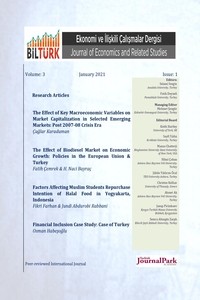Araştırma Makalesi
Yıl 2021,
Cilt: 3 Sayı: 1, 40 - 50, 25.01.2021
Öz
Kaynakça
- Barr, M. (2004). Banking the Poor, Yale Journal of Regulation, 21(1), pp. 121–237.
- Davidson, R. and MacKinnon, J.G. (1984). Convenient specification tests for logit and probit models, Journal of Econometrics, 25(3), pp. 241–262.
- Demirguc-Kunt, A. and Klapper, L. (2012). Measuring financial inclusion: The global Findex database. The World Bank.
- Gross, M. and Hogarth, J. (2012. Use of Financial services by the Unbanked and Underbanked and the Potential for Mobile Financial Services Adoption. Board of Governors of the Federal Reserve System. Federal Reserve Bulletin, 9 (4).
- Group, T.W.B. (2016). Global financial inclusion (global Findex) database. Available at: http://data.worldbank.org/data-catalog/financial_inclusion (Accessed: 28 February 2017). Hannig, A. and Jansen, S. (2010). Financial inclusion and financial stability: Current policy issues, SSRN Electronic Journal .
- Honohan, P. (2008). Cross-country variation in household access to financial services, Journal of Banking & Finance, 32(11), pp. 2493–2500.
- Levine, R. (2004). Finance and Growth: Theory and Evidence. NBER Working Paper No. 10766, National Bureau of Economic Research, Cambridge, MA. Available: www.nber.org/papers/ w10766.
- Tomilova, O. (2015). Progress and opportunities for financial inclusion in Turkey. Available at: http://www.cgap.org/blog/progress-and-opportunities-financial-inclusion-turkey (Accessed: 22 February 2017).
- Wooldridge, J.M. (2013). Introductory econometrics: A modern approach. 5th edn. Melbourne: South-Western College Publishing.
- Zhuang, J., Gunatilake, H.M., Niimi, Y., Khan, M.E., Jiang, Y., Hasan, R., Khor, N., Martin, A.L., Bracey, P. and Huang, B. (2004). Financial sector development, economic growth, and poverty reduction: A literature review, SSRN Electronic Journal,
Yıl 2021,
Cilt: 3 Sayı: 1, 40 - 50, 25.01.2021
Öz
Financial inclusion studies became a popular topic nowadays since; the new era development goals are mainly focus on the development of the under developed countries. Particularly, accessing to any form finance is called financial inclusion. Hence this study aims to examine to financial inclusion for women in Turkey. The main conclusion of the paper is that the people especially women who are in the lowest income level are more likely to be financially included to the fourth and third quartile income level. Furthermore, educated people tend to be financially included compere to the others. Lastly, age group of 25-50 are more likely to be financially included.
Anahtar Kelimeler
Kaynakça
- Barr, M. (2004). Banking the Poor, Yale Journal of Regulation, 21(1), pp. 121–237.
- Davidson, R. and MacKinnon, J.G. (1984). Convenient specification tests for logit and probit models, Journal of Econometrics, 25(3), pp. 241–262.
- Demirguc-Kunt, A. and Klapper, L. (2012). Measuring financial inclusion: The global Findex database. The World Bank.
- Gross, M. and Hogarth, J. (2012. Use of Financial services by the Unbanked and Underbanked and the Potential for Mobile Financial Services Adoption. Board of Governors of the Federal Reserve System. Federal Reserve Bulletin, 9 (4).
- Group, T.W.B. (2016). Global financial inclusion (global Findex) database. Available at: http://data.worldbank.org/data-catalog/financial_inclusion (Accessed: 28 February 2017). Hannig, A. and Jansen, S. (2010). Financial inclusion and financial stability: Current policy issues, SSRN Electronic Journal .
- Honohan, P. (2008). Cross-country variation in household access to financial services, Journal of Banking & Finance, 32(11), pp. 2493–2500.
- Levine, R. (2004). Finance and Growth: Theory and Evidence. NBER Working Paper No. 10766, National Bureau of Economic Research, Cambridge, MA. Available: www.nber.org/papers/ w10766.
- Tomilova, O. (2015). Progress and opportunities for financial inclusion in Turkey. Available at: http://www.cgap.org/blog/progress-and-opportunities-financial-inclusion-turkey (Accessed: 22 February 2017).
- Wooldridge, J.M. (2013). Introductory econometrics: A modern approach. 5th edn. Melbourne: South-Western College Publishing.
- Zhuang, J., Gunatilake, H.M., Niimi, Y., Khan, M.E., Jiang, Y., Hasan, R., Khor, N., Martin, A.L., Bracey, P. and Huang, B. (2004). Financial sector development, economic growth, and poverty reduction: A literature review, SSRN Electronic Journal,
Toplam 10 adet kaynakça vardır.
Ayrıntılar
| Birincil Dil | İngilizce |
|---|---|
| Konular | Ekonomi |
| Bölüm | Research Articles |
| Yazarlar | |
| Yayımlanma Tarihi | 25 Ocak 2021 |
| Kabul Tarihi | 7 Eylül 2020 |
| Yayımlandığı Sayı | Yıl 2021 Cilt: 3 Sayı: 1 |



